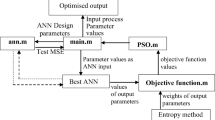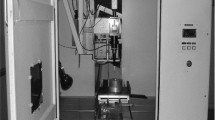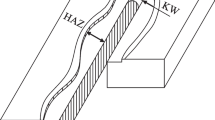Abstract
Aerospace and automobile industries employ aluminium alloys due to its lightweight and excellent resistance to corrosion. As aluminium is highly reflective and highly thermally conductive, it is difficult-to-cut material by laser processing. The quality characteristics of the cut predominantly depend upon the combination of laser processing parameters. The main quality indices for evaluating CO2 laser cutting were surface roughness, kerf width and kerf taper; and the machining parameters considered were laser power, speed and gas pressure. This work suggests hybrid artificial neural network (ANN)–particle swarm optimization (PSO) algorithm and artificial neural network (ANN)–genetic algorithm (GA) to optimize the associated multi-response characteristics during CO2 laser cutting of aluminium 6061 alloys. The results illustrate that the hybrid ANN–GA and ANN–PSO model is an efficient tool for the optimization of process parameters in CO2 laser cutting of difficult-to-cut material—aluminium. From the optimization results, it can be concluded that the proposed ANN–GA approach can be efficiently utilized to optimize the parameters for obtaining minimum roughness, kerf width and kerf taper.















Similar content being viewed by others
References
Davis JR (1998) Aluminum and aluminum alloys. ASM International, Metals Park, pp 6–7
Ujihara K (2006) Reflectivity of metals at high temperatures. J Appl Phys 43:2376–2383
Ciftci I (2006) Machining of austenitic stainless steel using CVD multi-layer coated cemented carbide tools. Tribol Int 39(6):565–569
Adalarasan R, Santhanakumar M, Rajmohan M (2015) Optimization of laser cutting parameters for Al6061/SiCp/Al2O3 composite using grey based response surface methodology (GRSM). Measurement 73:596–606
Dubey AK, Yadava V (2012) Laser beam machining—a review. Int J Mach Tools Manuf 48:609–628
Eltawahni HA, Hagino M, Benyounis KY, Inoue T, Olabi AG (2012) Effect of CO2 laser cutting process parameters on edge quality and operating cost of AISI316L. Opt Laser Technol 44:1068–1082
Stournaras P, Stavropoulos K, Salonitis G, Chryssolouris G (2009) An investigation of quality in CO2 laser cutting of aluminum. CIRP J Manuf Sci Technol 2:61–69
Javidi A, Riegger U, Eichlseder W (2008) The effect of machining on the surface integrity and fatigue life. Int J Fatigue 30:2050–2055
Lalwani DI, Mehta NK, Jain PK (2008) Experimental investigations of cutting parameters influence on cutting forces and surface roughness in finish hard turning of MDN250 steel. J Mater Process Technol 206:167–179
Mukherjee I, Ray PK (2006) A review optimizations techniques in metal cutting processes. Comput Ind Eng 50:15–34
Feng CXJ, Wang X (2002) Development of empirical models for surface roughness prediction in finish turning. Int J Adv Manuf Technol 20:348–356
Zain AM, Haron H, Sharif S (2010) Prediction of surface roughness in the end milling machining using artificial neural network. J Expert Syst Appl 37:1755–1768
Sharma VS, Dhiman S, Sehgal R, Sharma SK (2008) Estimation of cutting forces and surface roughness for hard turning using neural networks. J Intell Manuf 19:473–483
Zain AM, Haron H, Sharif S (2010) Application of GA to optimize cutting conditions for minimizing surface roughness in end milling machining process. Expert Syst Appl 37:4650–4659
Jiao Y, Lei S, Pei ZJ, Lee ES (2004) Fuzzy adaptive net-works in machining process modeling: surface roughness prediction for turning operations. Int J Mach Tools Manuf 44:1643–1651
Ozel T, Karpat Y, Figueira L, Davim JP (2007) Modeling of surface finish and tool flank wear in turning of AISI D2 steel with ceramic wiper inserts. J Mater Process Technol 189:192–198
Tansel IN, Ozcelik B, Bao WY, Chen P, Rincon D, Yang SY, Yenilmez A (2006) Selection of optimal cutting conditions by using GONNS. Int J Mach Tools Manuf 46:26–35
Ozel T, Nadgir A (2002) Prediction of flank wear by using back propagation neural network modeling when cutting hardened H-13 steel with chamfered and honed CBN tools. Int J Mach Tools Manuf 42:287–297
Tansel IN, Gulmez S, Demetgul M, Aykut S (2011) Taguchi Method-GONNS integration: complete procedure covering from experimental design to complex optimization. Expert Syst Appl 38:4780–4789
Sl M, Kwong CK, Lau WS (2001) A hybrid neural network and genetic algorithm approach to the determination of initial process parameters for injection moulding. Int J Adv Manuf Technol 18(6):404–409
Tansel IN, Ozcelik B, Bao WY, Chen P, Rincon D, Yang SY, Yenilmez A (2006) Selection of optimal cutting conditions by using GONNS. Int J Mach Tools Manuf 46(1):26–35
Wang K, Gelgele HL, Wang Y, Yuan Q, Fang M (2003) A hybrid intelligent method for modeling the EDM process. Int J Mach Tools Manuf 43(10):995–999
Ozcelik B, Oktem H, Kurtaran H (2005) Optimum surface roughness in end milling inconel 718 by coupling neural network model and genetic algorithm. Int J Adv Manuf Technol 27(3–4):234–241
Pandey AK, Dubey AK (2012) Simultaneous optimization of multiple quality characteristics in laser cutting of titanium alloy sheet. Opt Laser Technol 44:1858–1865
Pandey AK, Dubey AK (2013) Multiple quality optimization in laser cutting of difficult-to-laser-cut material using grey–fuzzy methodology. Int J Adv Manuf Technol 65(1–4):421–431
Dubey AK, Yadava V (2008) Laser beam machining—a review. Int J Mach Tools Manuf 48:609–628
Qiu P, Cui M, Kang K, Park B, Son Y, Khim E, Jang M, Khim J (2014) Application of Box–Behnken design with response surface methodology for modelling and optimizing ultrasonic oxidation of arsenite with H2O2. Cent Eur J Chem 12:164–172
Anand K, Barik BK, Tamilmannan K, Sathiya P (2015) Artificial neural network modeling studies to predict the friction welding process parameters of Incoloy 800H joints. Eng Sci Technol Int J 18:394–407
Adeli H, Hung SL (1994) Machine learning: neural networks, genetic algorithms, and fuzzy systems. Wiley, New York
Sardinas RQ, Santana MR, Brindis EA (2006) Genetic algorithm-based multi-objective optimization of cutting parameters in turning processes. Eng Appl Artif Intell 19(2):127–133
Author information
Authors and Affiliations
Corresponding author
Additional information
Technical Editor: Lincoln Cardoso Brandao.
Publisher's Note
Springer Nature remains neutral with regard to jurisdictional claims in published maps and institutional affiliations.
Rights and permissions
About this article
Cite this article
Vagheesan, S., Govindarajalu, J. Hybrid neural network–particle swarm optimization algorithm and neural network–genetic algorithm for the optimization of quality characteristics during CO2 laser cutting of aluminium alloy. J Braz. Soc. Mech. Sci. Eng. 41, 328 (2019). https://doi.org/10.1007/s40430-019-1830-8
Received:
Accepted:
Published:
DOI: https://doi.org/10.1007/s40430-019-1830-8




